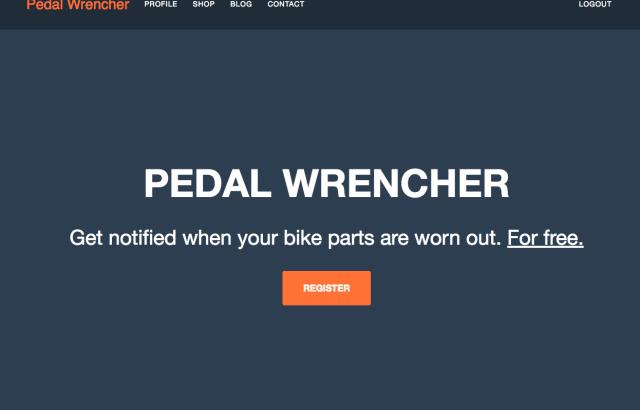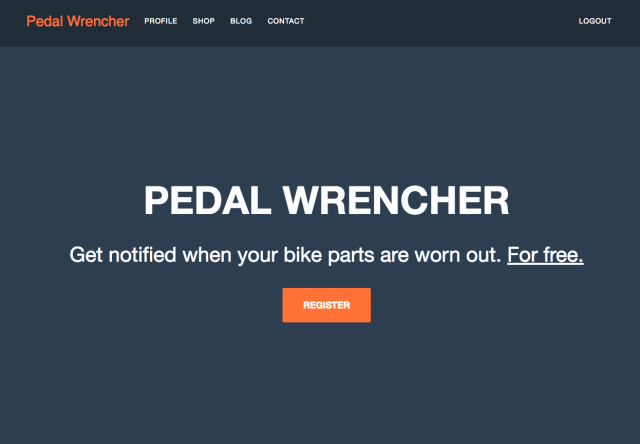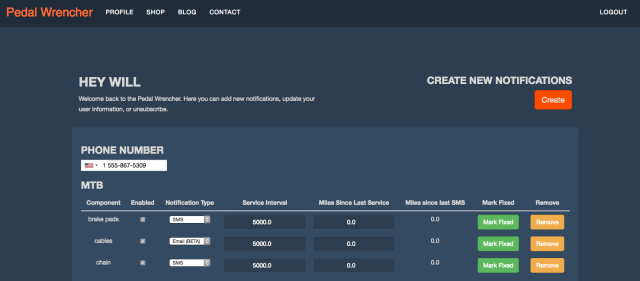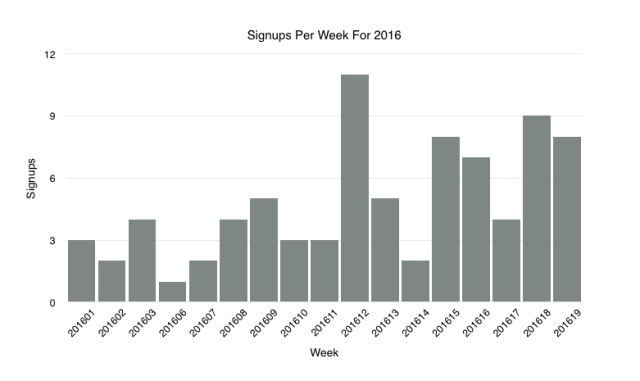In the past I’ve posted a few times about the creation and stagnation of a project of mine, pedal wrencher. In recent months I’ve taken a more structured approach to iteratively improving the app and the plan is to share the lessons learned along the way a bit more freely going forward. This is a high level post to get us started down that more technical path of posts and projects.
Where we’ve been; where we’re at
Before moving into recent developments, a quick recap for those that don’t know about pedal wrencher. Pedal wrencher is a really simple web app (built with python/flask) that will keep track of when you ride bikes (via Strava’s API) and send you an email or text message when it’s time to replace different parts (like chains, tires, bartape, etc). You can configure any sort of notification you want, so if you want to be reminded to wash your bike every 250 miles, it’s trivial to set that up. When you get a notification you go do that service, then either mark the notification fixed on your pedal wrencher profile or put a specific hashtag in the description of your next Strava ride, and we parse that out.
The eventual business model here is pretty straight forward, the nature of the service gives us the eyeballs of a consumer when we know that they need to buy a certain thing: a bike part. It’s pretty simple to add in something like target advertising, affiliate links, or even a bike-parts-as-a-service type of concierge delivery if there is enough volume to support that. So that’s where the rub is with this type of thing, there is no opportunity without users, so to build an opportunity for oneself, you have to first build something really useful for someone else.
So that’s the stage it is at today. The goal is to build a good and useful tool for cyclists and a sustainable means of growing that group of cyclists. Everything else can be sorted out later.
Growth
As is the case with may web projects, pedal wrencher had what felt like explosive growth early on, then died off. In the first week, it had 150 new users, a bunch of traffic, blog posts and news articles written about it; all sorts of good things. A week later that halved, and a week after that it halved again. When something is brand new it’s easy to get people’s attention, but sustained attention is a totally different thing.
So now there are a few tracks being pursued to improve pedal wrencher’s growth:
- Blog: pedal wrencher had close to zero organic search traffic, so we revamped the copy and added a blog to get some more content up. The blog has 2 main tracks:
- Repair tutorials, for how to do the maintenance itself once you get a certain notification
- New product features, explaining what pedal wrencher is, and how to use it
- FAQ and User Education: many people would sign up for pedal wrencher, and the immediately unsubscribe, or sign up and never make any changes to notification intervals or new notifications, leading me to believe that the usage wasn’t clear, so I added an FAQ to help answer some of that sort of question (in addition to the product feature blog posts)
- Profile Redesign: I added some bigger more obvious buttons to the profile page to make actions more obvious
- Streamlined Registration: Many users also would sign up and get about halfway through the registration process before dropping off, this was about 50% of all initiated signups. To cut down on that, I streamlined the registration process with some sensible defaults and cut down the process to one click.
- Social Media: I’m taking a more active role on twitter, trying to interact with people during major pro races and using the #strava hashtag.
And all of this is paying off, traffic to the website has grown consistently in the past few months of this effort, and is back up to the range of the 2nd week of hype. User signups have nearly tripled for an average week in the past quarter vs. Q4 of last year. Organic traffic is still weak (it’s largely twitter and existing users), but is growing as well.
As this work continues, I’ll periodically update posts here with what worked, what didn’t and whether it’s growing or not. Right now there are about 500 real users, with pretty varied engagement (some haven’t ever gotten a notification, some have tons set up and are regularly on the site).
Going Forward
This post has been pretty high level, and really serves as a starting point for more technicals posts in the future. There are a few things that I’d really like to do with this project, but if there is anything you think would be interesting, leave a comment below and I can look into it.
- A case for non-traditional sales channels in the cycling industry.
- Technical overview of what we are calculating, what we are storing, and how the data models work.
- Technical overview of the notification services (powered by Twilio and Mandrill).
- A/B testing with notifications to drive people back into the app more effectively, and how to do that.
- More detail on how the app was build with flask and cookiecutter-flask.
- Tutorials with twitter’s API and python for tracking hashtags and finding influencers.
- Being a responsible public API user and how to design APIs to help others do the same.
- Whatever else seems interesting as we move along.
So if you haven’t checked it out already, and do ride bikes, check out www.pedalwrencher.com, tell your friends, let me know what would make it better, and keep an eye out here for what I learn along the way.
The post Growing Pedal Wrencher appeared first on Will’s Noise.



